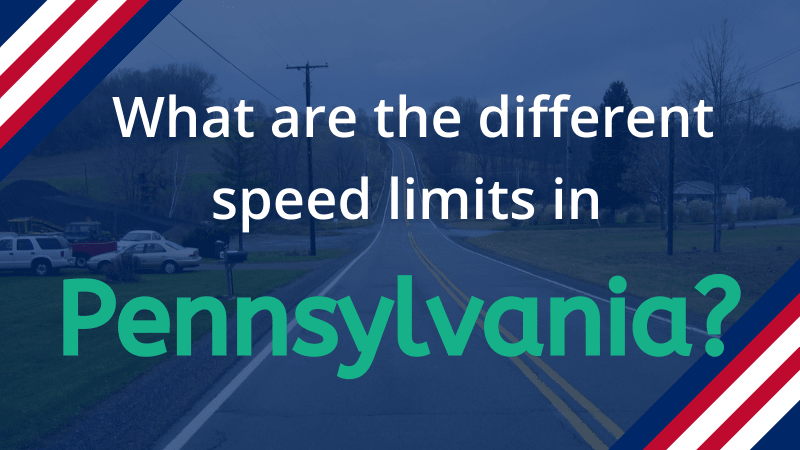Planning a trip to Pennsylvania? Maybe you are even organizing a move to the state or have only just relocated? There are many things to look forward to when you are in the Keystone State, including expansive and glorious landscapes spanning across the state, beautiful lush forests, and national parks.
There is much to consider if you have just moved to Pennsylvania or are planning a trip there, but one of the things you absolutely need to be aware of is the speed limit and the various speeds you can travel on different roads in Pennsylvania.
If you are a driver, planning on becoming a driver, or, are preparing to drive whilst visiting the state, or just simply passing through, knowledge of the different speed limits in Pennsylvania is especially important, whether in the cities, on the highways, or in any of the rural communities.
That is because speeding in Pennsylvania, like most places in the US, can and most likely will attract some hefty penalties and fines, and you don’t want to receive a speeding ticket in Pennsylvania as it can lead to having your license suspended through an accumulation of points!

Knowing the correct speed limit is not only about avoiding punishment. It is also about driving safely on the roads to prevent accidents. Driving within the speed limit helps reduce the possibility of crashes and promotes efficient use of the road.
In Pennsylvania, legislation is put in place to govern the safe use of the roads. Speed limits in Pennsylvania are established by the Pennsylvania Department of Transportation. The different limits indicate the fastest speeds you are legally allowed to drive when the conditions are good – that is when driving in fair weather and with good visibility, which is known as the “absolute speed limits”.
Of course, a specific signed speed limit does not always mean you have to drive at that exact pace all the time at all. In fact, you still need to assess the road conditions and surrounding environment to determine the best speed at which to drive (that is also within the stipulated limit).
This is called, the Basic Speeding Law, and prohibits driving at a speed that is “greater than is reasonable and prudent” under the driving conditions. The basic speeding law also makes it unlawful to “permit the driver to bring his (or her) vehicle to a stop within the assured clear distance ahead.” What this means is that you must drive at a sensible limit for the driving conditions during the day/night, and if you surpass the safe speed limit, then you may be fined and potentially further penalized.
What are the different Pennsylvania speed limits?
Different speed limits are implemented based on several factors, including population density and type of road. For each community and highway, the speed limits are often posted on prominent signs along the roadway.
The absolute Pennsylvania speed limits are as follows
- 15 mph in school zones.
- 25 mph in most residential districts.
- 35 mph in urban districts.
- 65/70 mph on highways (keep an eye on the signs).
- 70 mph on the Pennsylvania Turnpike (it used to be 65 mph prior to May 2016).
- 55 mph on all other roadways.
With these different speed limits implemented in Pennsylvania, it is important to pay attention to road signs. The last thing you want is to be slapped with a huge fine as a result of exceeding the state’s speed limits.
Most speeding violations committed in Pennsylvania will result in a $35 fine, plus $2 for every mile in excess of 5 mph over the limit. However, if the maximum speed limit is 65 mph or above, the fine is increased to $42.50 with the additional $2 for every mile in excess of 5 mph over the limit. Lastly, speeding in school zones by over 11 mph will result in fines costing as much as $500!
Moreover, being fined for exceeding Pennsylvania speed limits is just one way you may be punished. You can have between 2 – 3 points added to your license, in addition to an increase in your auto insurance premium. Take a look at our table to learn how each offense may lead to a certain number of points added to your license.
| Pennsylvania Speeding Ticket Points | Total Points |
|---|---|
| License restriction violation | 2 |
| Disobeying officer | 2 |
| Failure to stop at red light | 3 |
| Failure to yield to oncoming traffic | 3 |
| Improper passing | 3 |
| Following too closely | 3 |
| Failure to yield to driver at right at intersection | 3 |
| Failure to yield to oncoming driver when making left turn | 3 |
| Failure to stop at a stop sign | 3 |
| Failure to yield at yield sign | 3 |
| Failure to yield when crossing roadway | 3 |
| Failure to obey railroad signal | 2 |
| Failure to comply with crossing gate or barrier | 4 points and a 30-day suspension |
| Failure to stop for school bus | 5 points and a 60-day suspension |
| Driving too fast for conditions | 2 |
| Speeding 6 to 10 miles per hour over the limit | 2 |
| Speeding 11 to 15 miles per hour over the limit | 3 |
| Speeding 16 to 25 miles per hour over the limit | 4 |
| Speeding 26 or more miles per hour over the limit | 5 |
| Speeding in a school zone | 3 |
| Failure to yield to pedestrian on crosswalk | 2 |
| Failure to yield to pedestrian on sidewalk | 3 |
| Failure to yield to blind pedestrian | 3 |
| Careless driving | 3 |
| Leaving scene of an accident involving property damage | 4 |
When visiting or relocating your family to Pennsylvania, it is normal to think of all the funs things you can do. Knowledge of the speed limits – and adhering to them – will ensure your time is well spent and minimize the chance of you being fined.


